
By Kirstin Meyer - Oregon Institute of Marine Biology
September 28, 2012
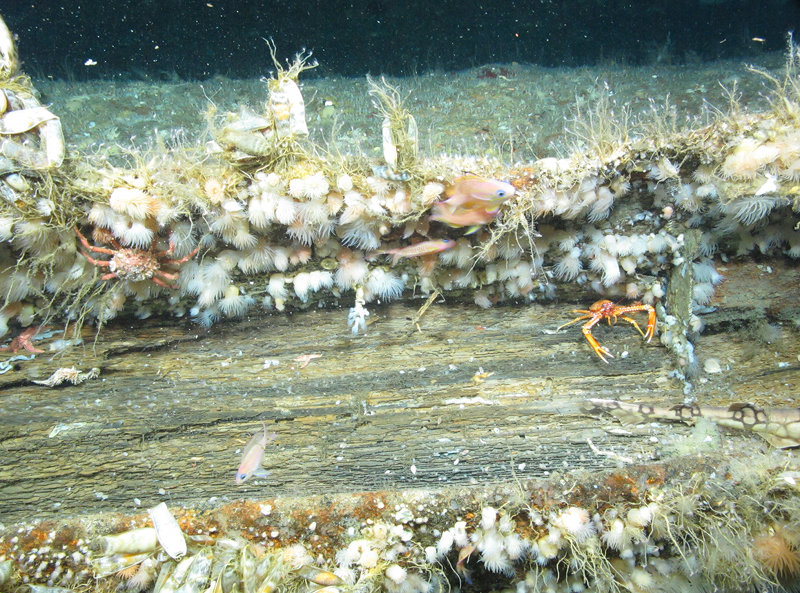
Typical inhabitants found on these shipwrecks. Shipwrecks serve as artificial reefs, hosting a wide variety of fauna including anemones, hydroids (thin yellow strands in this photo), spider crabs, and fish. Image courtesy of Deepwater Canyons 2012 Expedition, NOAA-OER/BOEM. Download larger version (jpg, 1.3 MB).
Imagine getting in your car and driving to the beach, but instead of stopping to gaze at the ocean, you keep driving straight into it. You drive across the sloping continental shelf, down the steep continental slope, all the way to the flat plains at the very bottom of the ocean. What would you see along the way?
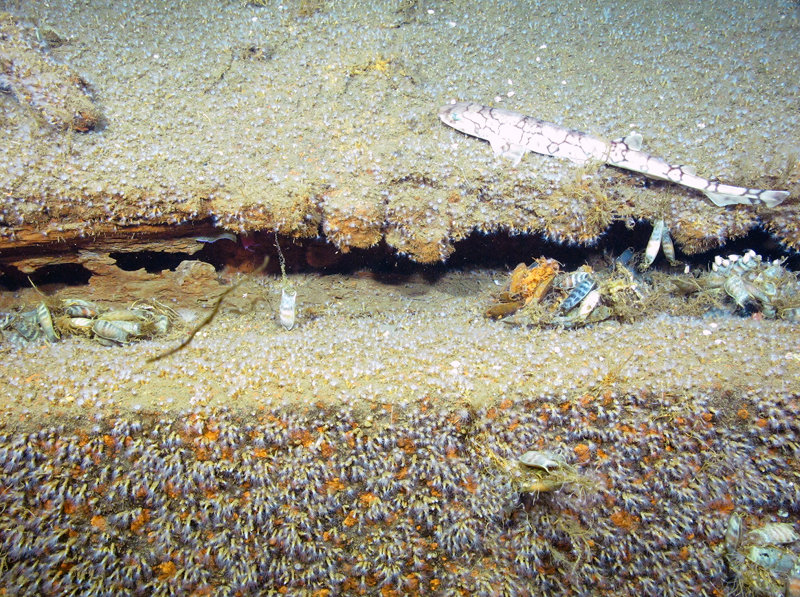
Chain dogfish shark and their egg casings are commonly found on the shipwrecks documented on the third leg of this mission. As seen in this picture, small, white, zoanthid anemones are also common and can cover much of the surface of a shipwreck. Image courtesy of Deepwater Canyons 2012 Expedition, NOAA-OER/BOEM. Download larger version (jpg, 1.5 MB).
Organisms that live on or associated with the ocean floor are called “benthic.“ On the flat, muddy plains of the deep ocean, they often aggregate around any structure they can find – rocks, trash, underwater mountains, and shipwrecks. These deep-ocean structures make life easier for benthic organisms in several ways, providing shelter and places to escape from predators, altering currents to possibly help filter-feeders feed, and giving a place for soft-bodied organisms to attach to something solid. The incredible number and variety of organisms found on various structures make them very different from the muddy plains around them!
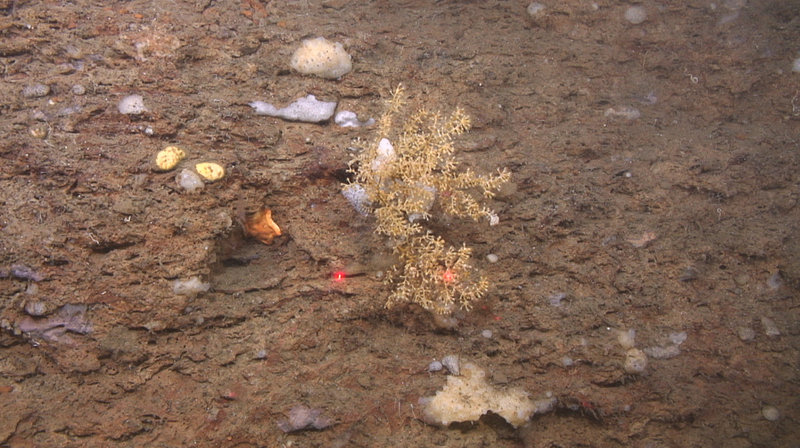
Benthic animal community in Norfolk Canyon. Image courtesy of Deepwater Canyons 2012 Expedition, NOAA-OER/BOEM. Download larger version (jpg, 714 KB).
My role on this expedition is to collect some of these benthic animals that have settled on underwater structures to hopefully identify them and learn more about them. Using a remotely operated vehicle (ROV), we’ve visited several shipwrecks, and every time we do, I marvel at what we find. Hydroids and anemones cover the metal surfaces of the wrecks, while sea stars, spider crabs, and dogfish loom around the structure. We’ve been able to obtain samples of some of the most common shipwreck inhabitants, which I’ve stored away in preservative to be identified once we get back on land. Once the organisms are identified, it will be possible to look back at the video recording of the ROV dive to count the organisms that live on and around the wreck and ultimately quantify the effects of the shipwreck structure on benthic biodiversity.
In addition to samples from the ROV, I’ve also helped process benthic samples collected by a trawl net. We’re using an otter trawl, which is basically a large net with a flat wooden “otter board“ on either side of the net mouth to keep it open. We tow it behind the ship just above the sea floor and thus catch a wide variety of benthic animals, which are sorted in the lab and preserved in formalin for identification back on land.
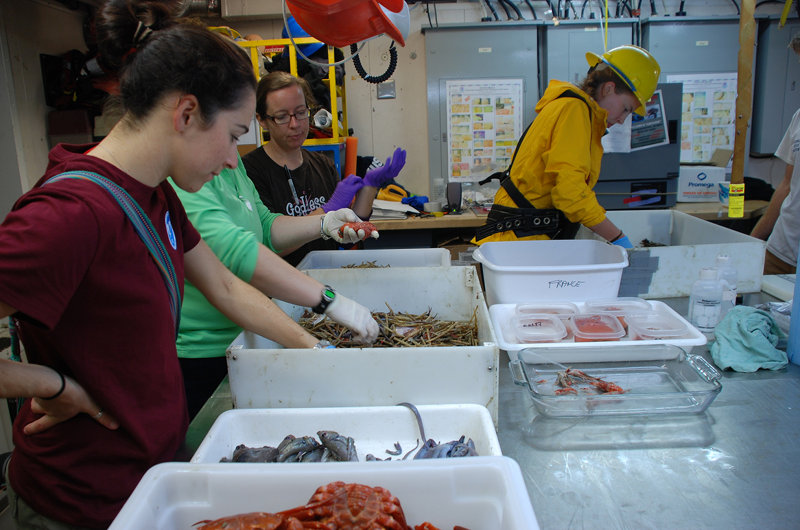
Specimens from the trawl net are taken into the wet lab and carefully sorted according to species by the science crew and then prepared for further study back home in the labs. Image courtesy of Deepwater Canyons 2012 Expedition, NOAA-OER/BOEM. Download larger version (jpg, 711 KB).
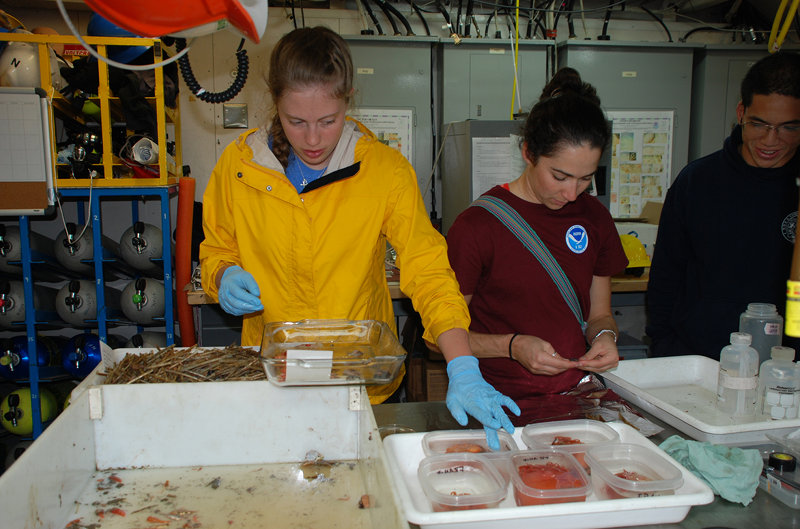
Kirstin Meyer and Megan Chesser sort and prepare specimens collected with the otter trawl while ENS Rick DeTriquet observes. Image courtesy of Deepwater Canyons 2012 Expedition, NOAA-OER/BOEM. Download larger version (jpg, 737 KB).
By analyzing the trawl samples, we can tell differences in the benthic community that inhabits the continental shelf and that which lives in deepwater canyons, another important structure of the deep ocean. The trawls can get very messy sometimes, especially if mud gets dragged up with the net! We’ve caught a diverse variety of shrimps, crabs, anemones, nudibranchs, polychaetes, dogfish, hagfish, and monkfish!
As a scientist, I have a passion to understand how the world works and why it is the way it is. Examining the organisms that inhabit structures at the bottom of the ocean teaches us a lot not only about the specific structures themselves (one specific shipwreck, for example) but also about how the presence of the structure in general affects what organisms live where. We have a wonderful opportunity to learn about the basic principles that form our world, and I’m extremely grateful to be a part of it.